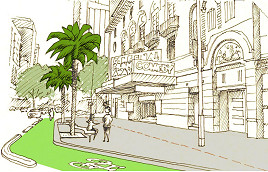“The Smith House” – 300 Queen St
By David Thompson, Royal Historical Society of Victoria
The Lord Mayor lampooned and criticised for questionable electioneering tactics! No, not 2018, we have stepped back in time 167 years.
The Lord Mayor was John Thomas Smith, known as the “Dick Whittington of the South” as he was seven times lord mayor between 1851 and 1864.
Smith was a well-known figure in white hat, white shirt frills and smoking a cutty pipe. He was a political conservative opposing a reduction in the miners’ licence fee (the cause of the Eureka uprising) and the introduction of the secret ballot in elections. However, he did support the eight-hour day and was greatly admired for both his generosity and active charity work.
Smith’s elegant three-story house, completed in 1852, still stands at 300 Queen St (on the east side of Queen St between Little Lonsdale and LaTrobe streets) and is one of the oldest residential buildings remaining in the Melbourne Central Business District.
It is built of stuccoed brick on a bluestone base with a large fanlight over the main entrance. The building has a simple symmetrical form, hipped slate-clad roof, Georgian windows and austere detailing. It is a fine example of pre-separation colonial Georgian architecture.
By 1859 Smith’s house was described in rate books as “brick, 17 rooms, hall, two cellars, coach house and stables”. But Smith had moved by this time to Mount Alexander Rd, Moonee Ponds and between 1859 and 1869 the house was used by the Victorian Government to accommodate various offices.
At one period during the gold rush, from about 1859 to 1862, so much gold was arriving in Melbourne from the goldfields of Ballarat and Bendigo that the house became the Treasury and Gold Offices and used for gold storage as an extension of the Treasury, at that time located in William St. By 1865 the building housed the Board of Agriculture, the Pleuro-Pneumonia Commissioners, and the Chief Inspector of Sheep’s Office.
Following a period of use as a boarding house, from about 1875 the building at 154 Queen St (the address only changed to 300 following Queen St re-numbering in about 1890) was occupied by David Munro. Munro was a successful railway contractor and one of the largest employers in Victoria. He also speculated in land and went bankrupt in the 1890s crash.
For the first 40 years or so of the 20th century the building again served as a boarding house. During the Second World War the building became the Queen Victoria Memorial Hospital Nurses Home and remained so for several years after the war. It was purchased by the Victorian Government in the 1950s and housed the Mental Hygiene Authority for several years. It is currently occupied by a department of Victoria University.
The date of our photograph is uncertain but a close inspection reveals the words “FURNISHED ACCOMMODATION - LODGINGS FOR GENTLEMEN” on the fanlight above the front door. Presumably the image dates from a period when the building served as a boarding house – obviously of superior quality!
An image of this building appears in Remembering Melbourne, a beautiful collection of photographs from across Melbourne and its suburbs.
Available from the RHSV for $35.

Council endorses office tower at Flinders Lane despite querying car park demolition






 Download the Latest Edition
Download the Latest Edition